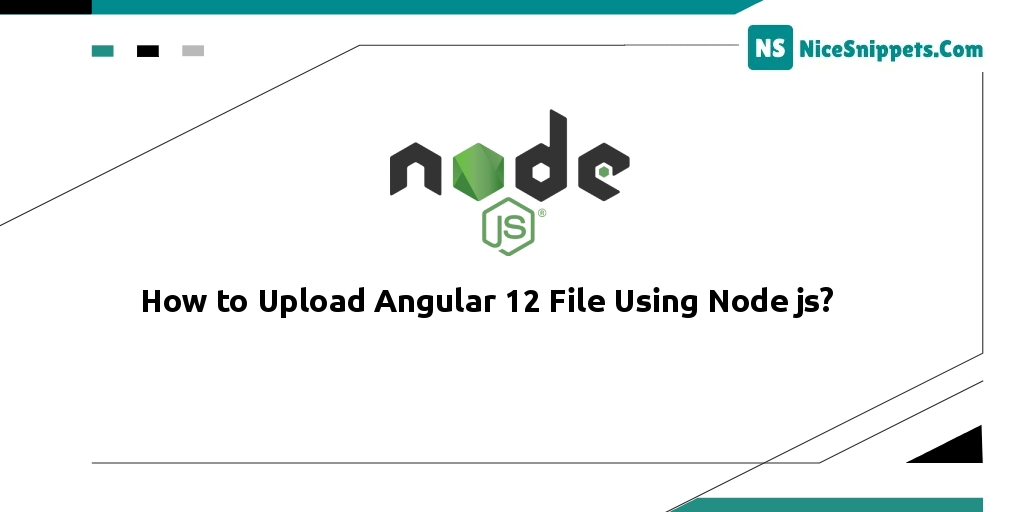25-Jan-2023
.
Admin

Hello Friends,
In this tutorial, I will show you a way to build Angular 12 with Node.js Express: File/Image upload & download example. You'll create the file upload request handler which will upload the file to the server.
This article is focused on how to upload an angular 12 file using node js. you can understand the concept of file upload using angular 12 and node.js. you will learn to implement file upload using node and angular. let’s discuss the angular 12 nodes and express js file upload tutorial. Here, Creating a basic example of an angular 12 upload image using a node.js server.
Create Angular Frontend App
Step 1: Create New Angular App
First of all, open your terminal and execute the following command on it to install the angular app:
ng new my-new-app
Step 2: Install ng-file-upload Directive & toastr Notification
Open your terminal and execute the following command to install ng-file-upload Directive & toastr Notification in angular 12 app:
npm install @angular/animations --save
npm install ng2-file-upload
Then, add the ngx-toastr CSS in angular.json file:
"styles": [
"src/styles.css",
"node_modules/ngx-toastr/toastr.css"
]
Step 3: Import Installed Modules on app.module.ts
Then, Open the app.module.ts file and import HttpClientModule, FormsModule, FileSelectDirective, and ToastrModule to the app.module.ts file like the following:
import { FileSelectDirective } from 'ng2-file-upload';
import { FormsModule } from '@angular/forms';
import { ToastrModule } from 'ngx-toastr';
@NgModule({
declarations: [
FileSelectDirective
],
imports: [
FormsModule
BrowserModule,
BrowserAnimationsModule,
ToastrModule.forRoot()
]
})
export class AppModule { }
Step 4: Create File Upload Form
In this step, create HTML markup for file upload form with input file element and image tag. So, visit src/app/app.component.html and update the following code into it:
<div class="wrapper">
<h2>Angular Image Upload</h2>
<div class="file-upload">
<input type="file" name="image" ng2FileSelect [uploader]="uploader" accept="image/x-png,image/gif,image/jpeg" />
<button type="button" (click)="uploader.uploadAll()" [disabled]="!uploader.getNotUploadedItems().length">
Upload
</button>
</div>
</div>
Step 5: Import Components app.component.ts
In this step, visit the src/app directory and open app.component.ts. Then add the following code into it:
import { Component, OnInit } from '@angular/core';
import { FileUploader } from 'ng2-file-upload/ng2-file-upload';
import { ToastrService } from 'ngx-toastr';
const URL = 'http://localhost:3000/upload';
@Component({
selector: 'app-root',
templateUrl: './app.component.html',
styleUrls: ['./app.component.css']
})
export class AppComponent implements OnInit {
public uploader: FileUploader = new FileUploader({
url: URL,
itemAlias: 'image'
});
constructor(private toastr: ToastrService) { }
ngOnInit() {
this.uploader.onAfterAddingFile = (file) => {
file.withCredentials = false;
};
this.uploader.onCompleteItem = (item: any, status: any) => {
console.log('Uploaded File Details:', item);
this.toastr.success('File successfully uploaded!');
};
}
}
Then execute the following command on the terminal to start the app to check out the File upload in the browser:
ng serve --open
Create Node Express JS Backend
Step 1: Create Node JS App
Open your terminal and execute the following command to create node js app:
mkdir my-app
cd my-app
npm init -y
Step 2: Install Express body parser and cors Dependencies
Execute the following commands to install imperative npm packages which will help us to create REST APIs for your angular file upload app:
npm install express express-fileupload body-parser cors
npm install nodemon --save-dev
Step 3: Create Server.js File
In this step, add the following code into it:
p
const express = require("express");
const fileupload = require("express-fileupload");
const cors = require("cors");
const bodyParser = require('body-parser');
const app = express();
app.use(cors());
app.use(fileupload());
app.use(express.static("files"));
app.use(bodyParser.json());
app.use(bodyParser.urlencoded({ extended: true }));
app.post("/upload", (req, res) => {
const newpath = __dirname + "/files/";
const file = req.files.file;
const filename = file.name;
file.mv(`${newpath}${filename}`, (err) => {
if (err) {
res.status(500).send({ message: "File upload failed", code: 200 });
}
res.status(200).send({ message: "File Uploaded", code: 200 });
});
});
app.listen(3000, () => {
console.log("Server running successfully on 3000");
});
Step 4: Start Node JS App
Start the server with the following command and then you can test the form:
npm start
OR
nodemon server.js
I hope it can help you...
#Node JS